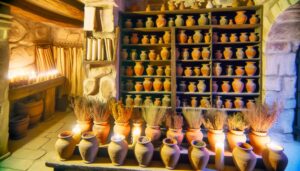Caldron Meaning In The Bible: Judgment and Purification
In the Bible, a caldron is a large metal pot used primarily for sacrificial rites and communal feasts, symbolizing abundance, sustenance, and shared communal meals. In the Old Scriptures, caldrons were integral in preparing sacrificial offerings, while in the New Scriptures, they serve as metaphors for the shift from ritualistic practices to inner spirituality.
Additionally, caldrons represent divine purification and judgment, symbolizing the cleansing of moral impurities through fire. Prophetic literature uses caldrons to convey divine messages about impending calamities and the transformative nature of trials.
Exploring these themes reveals deeper insights into their symbolic significance.
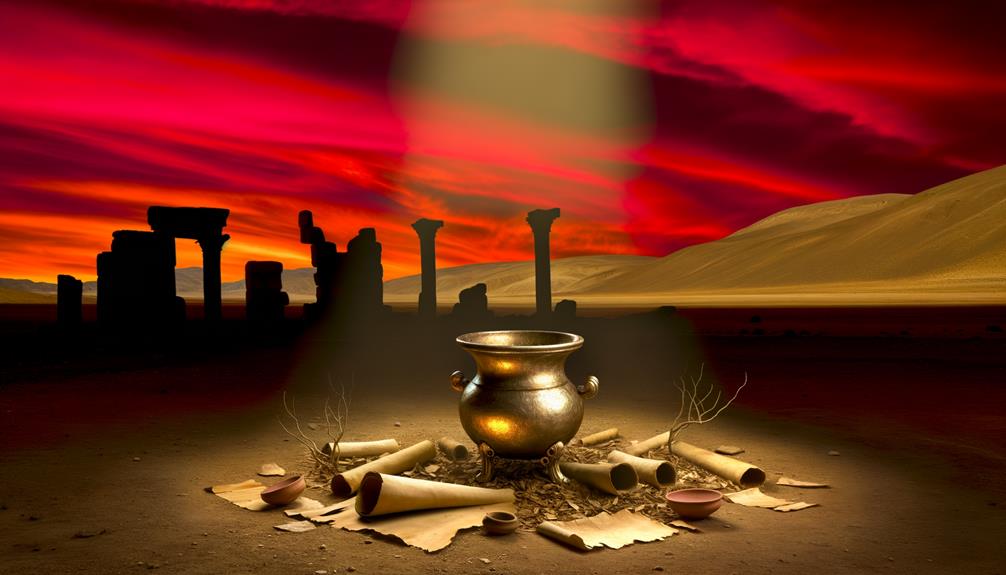
Caldron Meaning in the Bible: Symbolism and Scriptural Insights
| Aspect | Explanation |
|---|---|
| Definition | A large pot used for boiling or cooking |
| Biblical Usage | Symbol of judgment, destruction, or purification |
| Key Verses | Ezekiel 11:3, 11:7 – Refers to Jerusalem as a caldron of judgment |
| Symbolic Meaning | Represents God’s wrath, refining, or corrupt leadership |
| Spiritual Lesson | Warns against complacency and highlights divine justice |
Definition of Caldron
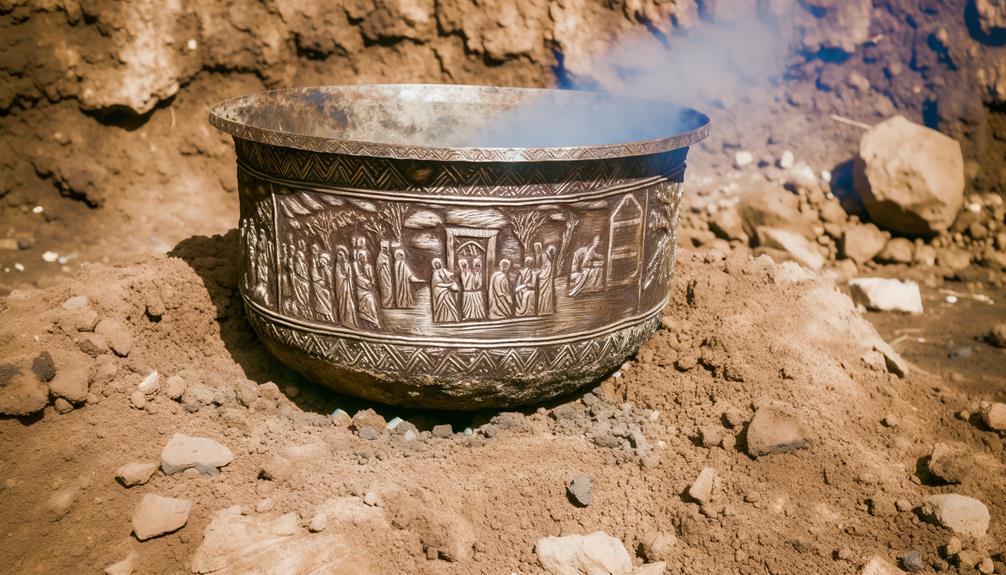
In biblical literature, the term ‘caldron‘ refers to a large metal pot or kettle used for cooking or boiling, often mentioned in contexts that highlight communal gatherings and ritualistic practices.
This vessel, typically made of durable metals like bronze or iron, served a practical function in ancient societies, facilitating the preparation of large quantities of food.
Its significance extends beyond mere utility; the caldron often symbolizes abundance, sustenance, and the shared experience of communal meals.
In various scriptural passages, the caldron is intricately connected to sacrificial rites and offerings, reflecting its integral role within the religious and social fabric of the time.
Understanding the caldron’s multifaceted role provides deeper insight into the communal and ritualistic life of ancient biblical cultures.
Caldron in Old Testament
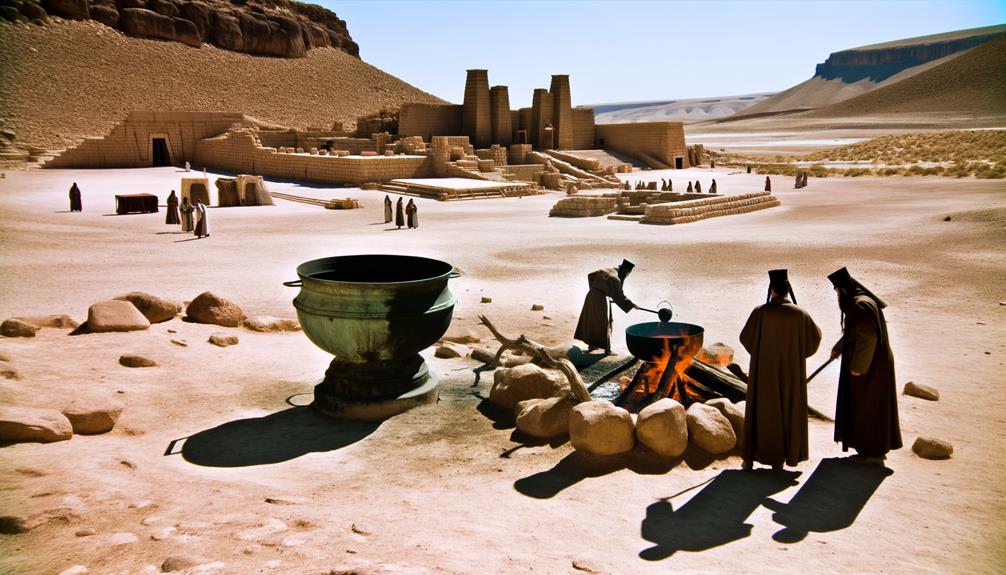
Throughout the Old Covenant, the caldron emerges as a significant artifact, frequently associated with religious ceremonies and communal feasts, reflecting its profound role in the spiritual and social practices of the Israelites.
In texts such as 1 Samuel 2:14, caldrons are depicted as vessels for preparing sacrificial meat, emphasizing their integral role in offerings to Yahweh.
The use of caldrons in communal settings, as noted in 2 Chronicles 35:13 during the Passover, underscores their function in fostering community unity and observance of divine commandments.
These instances highlight the caldron’s dual symbolism: a practical tool for sustenance and a sacred vessel for devotion, underscoring its multifaceted importance within the ancient Israelite culture.
Caldron in New Testament
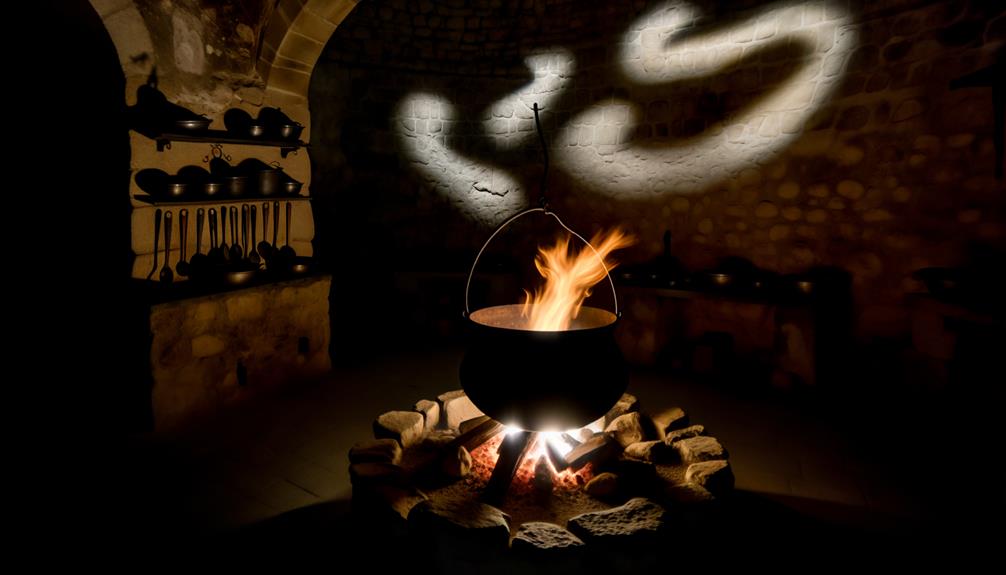
While the Old Scripture frequently highlights the caldron’s role in religious and communal life, the New Scripture offers a distinct perspective on this artifact, reflecting the evolving spiritual landscape and practices of early Christians.
In the New Covenant, the caldron is less frequently mentioned, symbolizing a shift from ritualistic practices to a focus on internal spirituality and communal fellowship. This change underscores the movement from Jewish ceremonial law to Christian doctrines emphasizing inner purity and moral integrity.
The caldron, when referenced, serves as a metaphorical tool rather than a literal vessel, illustrating the transformation from external rites to internal faith. This nuanced approach mirrors the broader thematic evolution within the New Covenant, emphasizing personal salvation and ethical living over ritualistic observance.
Symbolism of Purification

The imagery of the caldron in biblical texts often signifies the dual aspects of purification: cleansing through fire and the process of spiritual renewal.
Fire, as a purifying agent, symbolizes the eradication of impurities, both physical and moral, preparing individuals or communities for a sanctified state.
This purification process underscores a transformative journey, where the caldron serves as a metaphor for the trials that refine and elevate one’s spiritual essence.
Cleansing Through Fire
In biblical literature, fire frequently serves as a potent symbol of purification, representing the transformative process of cleansing impurities and refining the human spirit.
This symbolism is vividly illustrated in passages such as Malachi 3:2-3, where God is portrayed as a refiner’s fire purifying the Levites.
The metaphor extends to the caldron, an instrument used for melting and purging metals of dross. In this situation, it signifies a divine mechanism through which moral and spiritual impurities are expunged.
This cleansing through fire underscores a rigorous, often arduous process indicative of divine judgment and mercy, aiming to restore righteousness and holiness.
Accordingly, fire and the caldron together encapsulate a profound theological narrative of purification and divine intervention.
Spiritual Renewal Process
Rooted in the symbolism of purification, the spiritual renewal process in biblical scripture often employs the imagery of fire and the caldron to convey the transformative journey towards holiness and divine acceptance.
In texts such as Malachi 3:2-3, the Lord is depicted as a refiner’s fire and a purifier of silver, emphasizing the intense and sometimes painful process of spiritual refinement.
The caldron serves as a metaphorical vessel where impurities are burned away, leaving behind pure, sanctified elements. This powerful imagery underscores the necessity of enduring trials and tribulations to achieve spiritual purity.
Symbolism of Judgment
Biblical texts often employ the image of a caldron to symbolize divine judgment and purification, reflecting the intense and transformative nature of God’s scrutiny.
This symbolism is vividly depicted in passages such as Ezekiel 24:3-14, where the boiling caldron represents Jerusalem under siege, illustrating the city’s trials and purging through suffering.
The caldron’s searing heat signifies God’s righteous anger, aiming to cleanse and correct. This metaphor underscores the dual nature of divine judgment—not merely punitive but also redemptive.
Symbolism of Transformation

The caldron in biblical texts serves as a potent symbol for the process of spiritual purification, wherein impurities are metaphorically burned away to refine one’s soul.
This transformative imagery also extends to the representation of divine wrath, illustrating how intense trials can serve as a crucible for personal and communal renewal.
Consequently, the caldron embodies both the destructive and redemptive aspects of divine intervention.
Spiritual Purification Process
In the context of biblical symbolism, the caldron often represents a crucible for spiritual purification and transformation, acting as a metaphorical vessel through which impurities are burned away, leading to a state of refined spiritual clarity.
This imagery is rooted in passages that depict the caldron as a means to separate the impure from the pure, much like the process of refining metals.
The intense heat signifies trials and tribulations that one must endure to achieve a higher spiritual state.
This process underscores the necessity of hardship in the journey toward sanctification, echoing the biblical theme that personal growth and spiritual enlightenment often emerge from enduring and overcoming life’s challenges.
Divine Wrath Representation
Depicting divine wrath through the symbolism of the caldron, scripture often illustrates it as a transformative force, purging iniquity and catalyzing moral and spiritual renewal. This vivid imagery serves to emphasize the purifying nature of divine judgment.
The caldron, as a vessel of intense heat, signifies the process through which impurities are eradicated, leaving behind a refined essence.
Key elements of this symbolism include:
- Judgment as Purification: Divine wrath is not merely punitive but aims to cleanse.
- Heat as Catalyst: The intense heat represents the trials that lead to spiritual growth.
- Transformation through Tribulation: Difficult experiences shape and refine character.
This multifaceted symbolism underscores the redemptive purpose behind divine wrath.
Caldron in Prophetic Books

Exploring the symbolism of the caldron in prophetic books reveals a rich tapestry of metaphorical meaning, often associated with divine judgment and purification.
In Jeremiah 1:13-14, the boiling caldron represents impending calamity from the north, symbolizing divine retribution against Judah.
Similarly, Ezekiel 24:3-14 employs the caldron as a metaphor for Jerusalem, destined to endure severe trials as impurities are purged through intense heat.
This imagery underscores the prophetic theme of purification through suffering, where the caldron serves as a vessel for enacting God’s will and refining His people.
Hence, the caldron in prophetic literature is a powerful symbol of both imminent judgment and the transformative process of spiritual cleansing.
Caldron in Historical Books
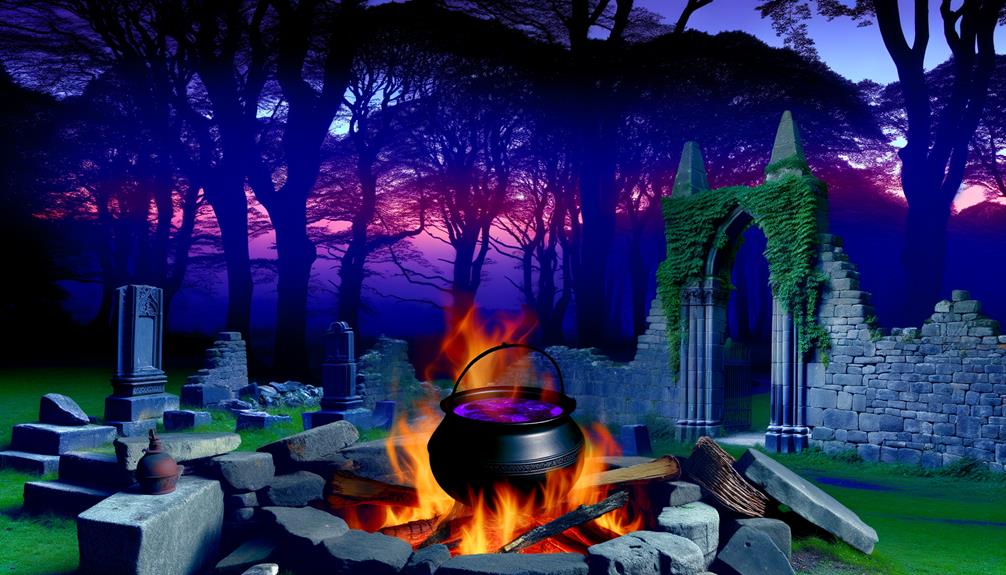
While prophetic books use the caldron as a rich symbol of divine judgment and purification, historical books such as 1 Samuel provide a more literal depiction, where the caldron serves as a practical tool used in sacrificial rituals and communal feasts, reflecting its significance in the daily religious practices of ancient Israel.
These texts highlight the caldron’s utilitarian role, underscoring its importance in various societal functions:
- Sacrificial Offerings: Used to boil sacrificial meats.
- Communal Gatherings: Central to feasts and community meals.
- Religious Ceremonies: Integral in the preparation of offerings.
Such depictions offer a window into the everyday life and religious observances of the ancient Israelites.
Caldron in Psalms and Proverbs

In Psalms and Proverbs, the caldron frequently serves as a potent symbol and image, encapsulating profound spiritual and moral lessons.
Proverbs utilizes the caldron to underscore themes of purification and judgment, reflecting the wisdom literature’s broader focus on moral and ethical conduct.
Meanwhile, Psalms employs caldron imagery to evoke powerful metaphorical interpretations, often illustrating the intensity of divine intervention and human suffering.
Symbolism in Proverbs
A thorough analysis of the caldron’s symbolism in Proverbs and Psalms reveals its nuanced representation of divine judgment and purification. Within these biblical texts, the caldron often serves as a metaphorical vessel, illustrating the process by which God’s justice and moral refinement operate. This imagery conveys profound theological insights, emphasizing the transformative power inherent in divine intervention.
- Divine Judgment: The caldron is a symbol of God’s righteous judgment, where impurities are burned away.
- Purification: It underscores the necessity of purification to achieve spiritual holiness.
- Transformation: The heat of the caldron signifies the trials and tribulations essential for personal growth.
- Wisdom: Proverbs often uses the caldron to highlight the wisdom gained through enduring divine processes.
This layered symbolism enriches our understanding of divine principles in biblical literature.
Imagery in Psalms
The caldron in Psalms, much like in Proverbs, serves as a potent symbol of divine judgment and purification, encapsulating the dynamic interplay between suffering and spiritual refinement.
Within Psalms, the imagery of the caldron often parallels the tribulations faced by the faithful, signifying a divine process where impurities are purged and righteousness is fortified.
Psalms 58:9, for instance, employs the caldron imagery to depict the swiftness of God’s judgment, emphasizing the immediacy and thoroughness of divine intervention.
Similarly, this metaphor underscores the essential theme of transformation through trials, a recurrent motif that resonates with the overarching narrative of redemption and divine justice.
Consequently, the caldron becomes a vessel of both wrath and mercy within the Psalms’ rich tapestry of imagery.
Metaphorical Interpretations
Metaphorical interpretations of the caldron in Psalms and Proverbs reveal a profound symbolic framework that intertwines themes of divine judgment, purification, and moral fortitude. These texts use the caldron to illustrate the spiritual and ethical testing that individuals undergo.
- Divine Judgment: The caldron symbolizes God’s method of evaluating the righteousness of His people.
- Purification: It represents the process by which impurities are removed, aligning with the notion of spiritual cleansing.
- Moral Fortitude: The imagery underscores the strength required to endure such trials.
- Transformation: The caldron metaphorically conveys the transformative journey from sin to sanctity.
This interpretive lens enriches the understanding of how Biblical wisdom literature portrays the divine-human relationship.
Modern Interpretations

In modern theological scholarship, the term ‘caldron’ is often reinterpreted through various symbolic and cultural lenses to uncover deeper spiritual and societal implications. These interpretations can range from views on purification and judgment to themes of community and transformation.
Scholars compare ancient symbolism with contemporary issues, providing a rich, multifaceted understanding of the term. By analyzing the ‘caldron’ in different contexts, modern interpretations offer nuanced perspectives that resonate with current societal dynamics.
| Modern Interpretation | Symbolism/Implication |
|---|---|
| Purification | Spiritual cleansing |
| Judgment | Divine retribution |
| Community | Collective transformation |
| Transformation | Personal growth |
| Cultural Relevance | Contextual understanding |
This thorough approach underscores the enduring relevance of biblical symbols in addressing today’s challenges.
Conclusion
The caldron, a vessel of both literal and metaphorical significance, traverses the biblical narrative as a symbol of purification, judgment, and divine intervention.
From the prophetic forewarnings to the poetic musings in Psalms and Proverbs, its presence underscores a profound theological allegory.
In the crucible of faith, the caldron refines and reveals the essence of human and divine interaction, embodying the transformative power inherent in the sacred texts.
This ancient symbol continues to resonate with contemporary interpretations, bridging historical context with modern spiritual reflection.


